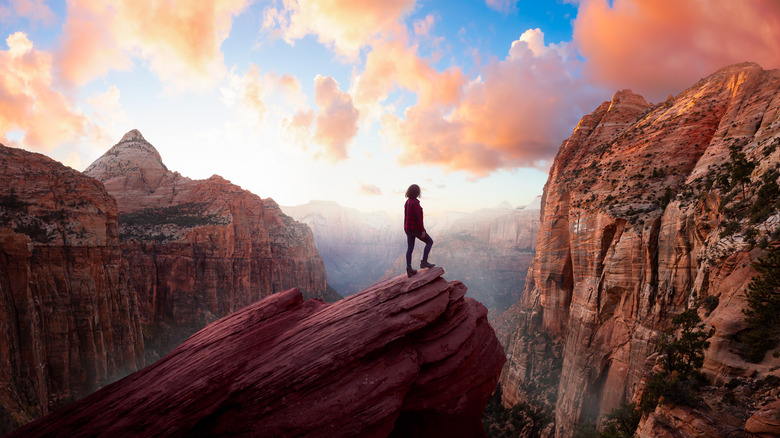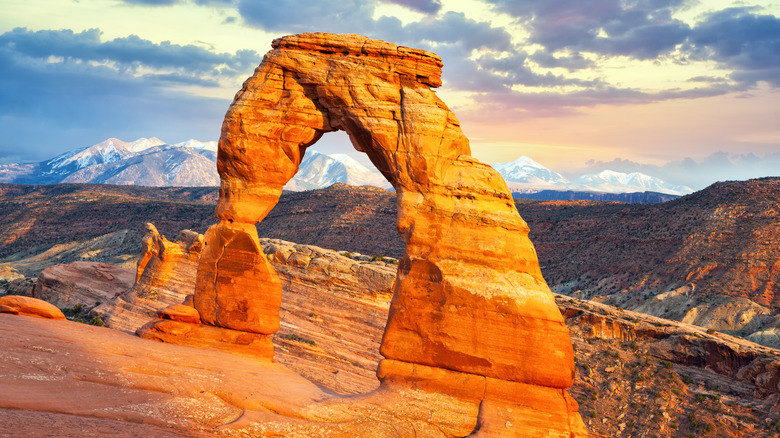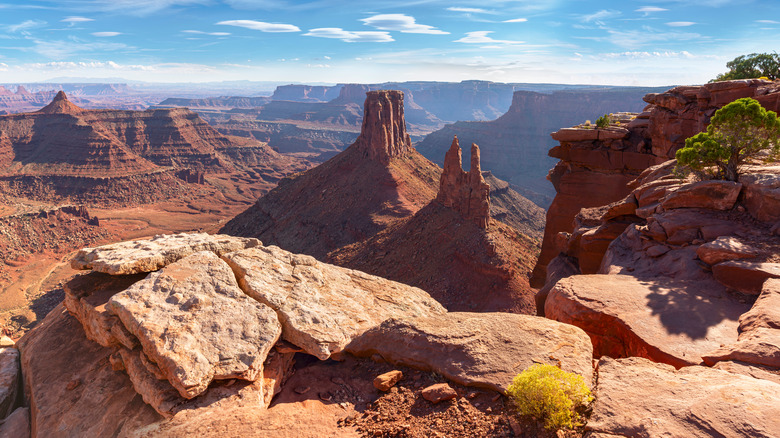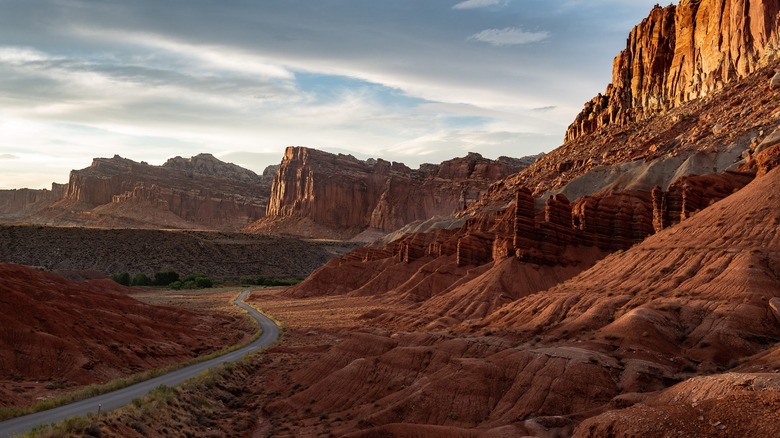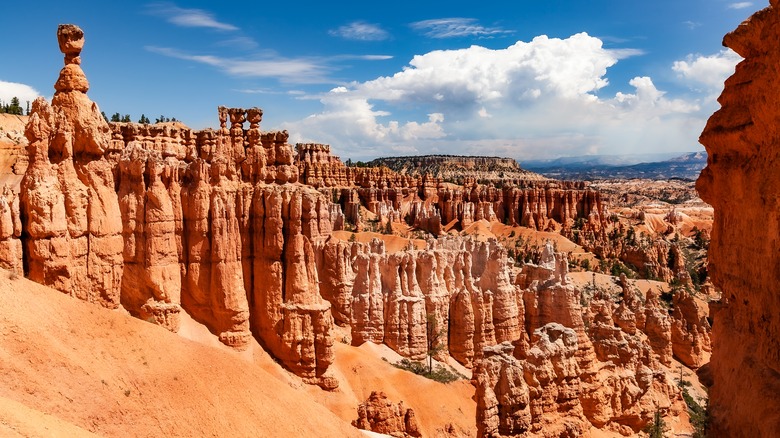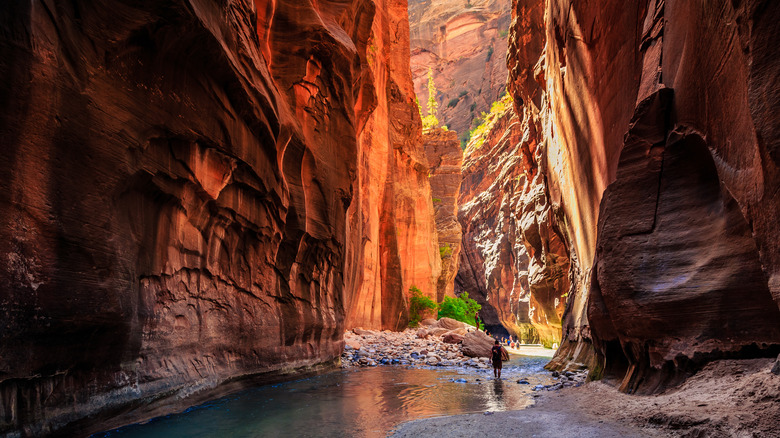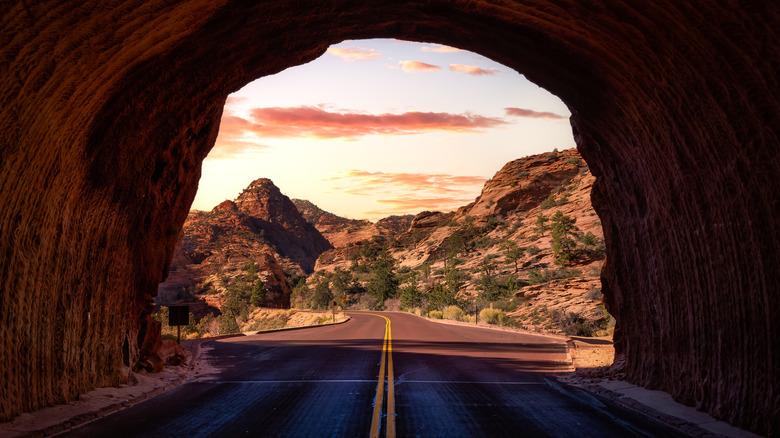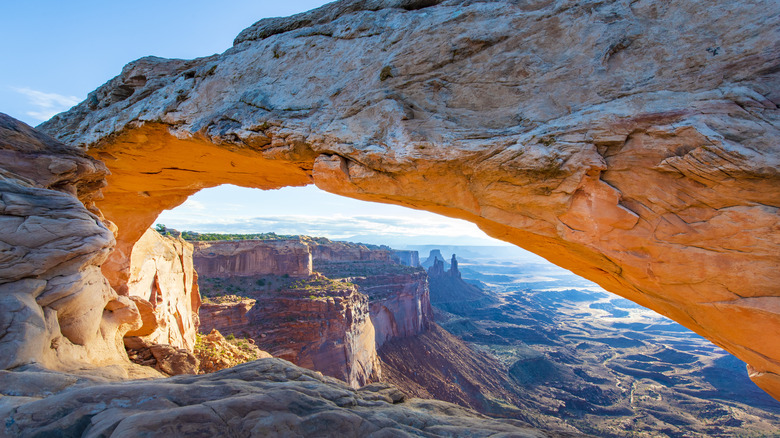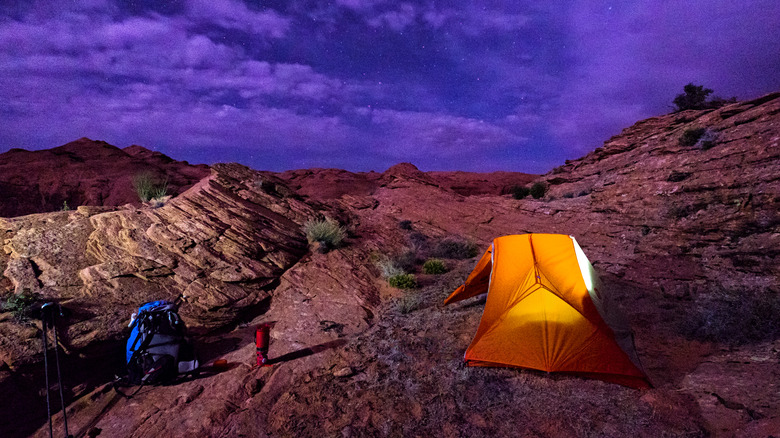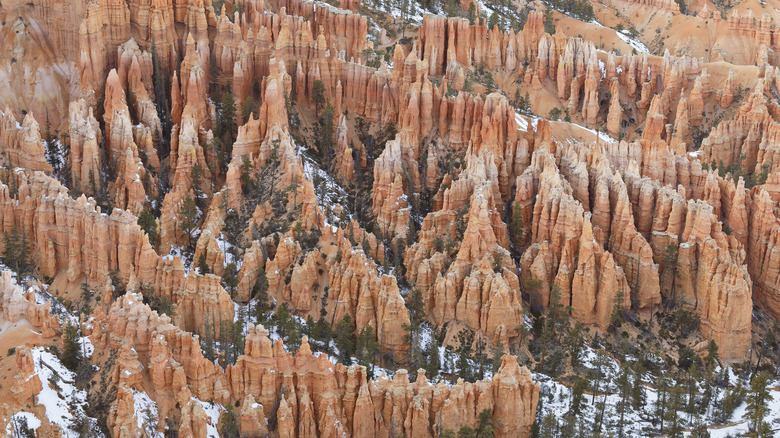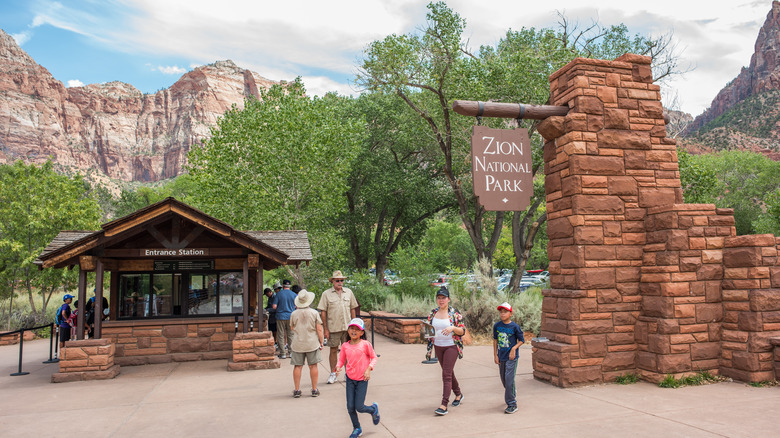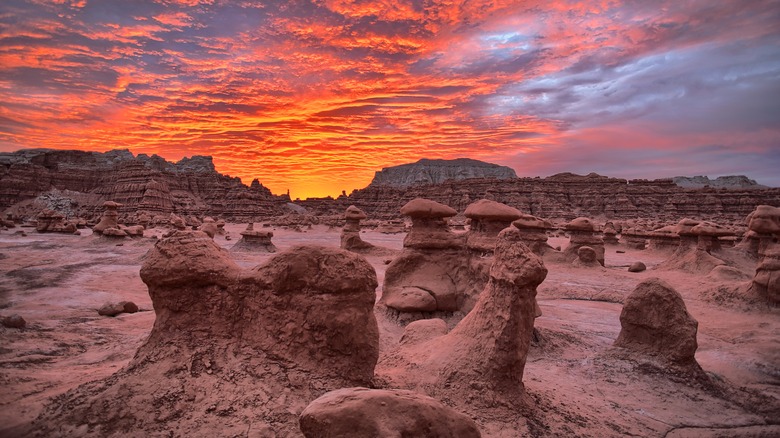11 Things To Know About Utah's Mighty 5 Road Trip
Utah's Mighty 5 National Parks are a group of stunning and diverse natural parks in the southern part of the state that showcase the unique and breathtaking landscapes of the Beehive State. The national parks in question include Arches National Park, Canyonlands National Park, Capitol Reef National Park, Bryce Canyon National Park, and Zion National Park. The Mighty 5 road trip is an increasingly popular adventure through Utah that allows you to not only hit all five national parks but also offers you the experience of enjoying mini adventures and activities along the way.
Each park has its best time of year to visit, depending on whether you prefer warmer weather or winter sceneries. Your choice of season to visit can limit which activities you can take part in, along with possible closures due to snow and ice. Remember to plan ahead for required day passes or reservations for each of the Mighty 5, as well as with any mini parks you plan to visit while on the road. There are typically three routes to travel through each park, leaving from Salt Lake City, Colorado, or Las Vegas. No matter which route you take, the distance between each park can be substantial and take plenty of time to cover, especially with several stops. It is worth it, of course, so be prepared for diverse landscapes and climates, especially if you're camping or staying for the day, and get ready to enjoy a truly incredible adventure.
Starting at Arches National Park
Moab serves as the gateway to the Mighty 5, offering the perfect starting point for exploration, as Arches National Park sits just north of town. This stunning national park in southern Utah is known for its unique and otherworldly red rock formations. This park includes over 2,000 natural stone arches, as well as hundreds of soaring pinnacles, giant fins, and balanced rocks. The park's inspiring red-hued, sandstone terrain has been sculpted by erosion and weathering over millions of years, resulting in a visually striking and otherworldly environment.
The park covers an area of over 76,000 acres and is situated on the Colorado Plateau. Some of the most famous and iconic arches in the park are Landscape Arch, Double Arch, and Delicate Arch, the latter of which is often featured in promotional material and also represents the state of Utah on its license plates. There are plenty of activities you can plan to do during the day and night, such as park ranger-guided tours and hikes, individual hikes, and a spot of romantic stargazing.
From Arches National Park to the Canyonlands
Canyonlands National Park is divided into four districts by the rivers: Island in the Sky, The Needles, The Maze, and The Rivers, and is known for its stunning vistas, deep canyons, towering mesas, and unique geological formations. It provides opportunities for hiking, backpacking, and stargazing, all of which allow visitors to experience the beauty of the desert landscape. Each district has its own distinct character, making Canyonlands a diverse and captivating destination for nature enthusiasts.
Island in the Sky is known for its expansive mesa-top views of canyons and deep, dramatic cliffs and provides an excellent vantage point for breathtaking panoramas. The Needles, named after the colorful spires of Cedar Mesa Sandstone, offers hiking trails that take visitors through a maze of unique rock formations. The Maze is remote and difficult to access, but those who make the effort find a rugged and wild area for experienced backpackers and adventurers. It offers an authentic backcountry experience with limited services and requires careful planning. The Rivers district includes the Colorado River and Green River that flow through the park, carving deep canyons and offering thrilling conditions for river rafting and kayaking.
Arriving in Capitol Reef Country
Established in 1971, Capitol Reef National Park is all about rugged and colorful landscapes, including cliffs, canyons, domes, and bridges. Its moniker refers to the white domes of Navajo Sandstone that resemble the U.S. Capitol building and the rocky cliffs that create a barrier to access, similar to a reef. Capitol Reef National Park typically offers a quieter and less crowded experience compared to the other Mighty 5 parks. It provides a variety of notable hiking trails suitable for different skill levels, such as the Hickman Bridge Trail, the Grand Wash Trail, and the Capitol Gorge Trail. These trails offer unique opportunities to see petroglyphs, natural arches, and sweeping panoramic views.
One fascinating feature of Capitol Reef is the Waterpocket Fold, a nearly 100-mile-long warp in the Earth's crust, creating a rugged and scenic spine through the park. Capitol Reef is also packed with historic fruit orchards planted by Mormon pioneers in the late 19th century. Visitors can sometimes pick and enjoy apples, pears, and cherries during harvest. Panorama Point and Sunset Point are popular scenic overlooks that provide breathtaking views of the Waterpocket Fold and the surrounding canyon. Capitol Reef also has minimal light pollution, so you can expect fabulous stargazing conditions and the chance to participate in the park's astronomy programs.
From Capitol Reef to Bryce Canyon
Bryce Canyon National Park is also known for its unique geological structures, but these phenomena are something else. They are called hoodoos, which are tall, thin rock spires that protrude from the bottom of Bryce's amphitheaters, and they are a stunning sight. Despite its high elevation and winter snow, Bryce Canyon is a year-round destination, offering different and equally captivating experiences no matter the season. The park's hoodoos and stunning vistas make it a popular destination for photographers and nature enthusiasts, and it has more than several incredible hikes for everyone, from beginners to experienced hikers.
Bryce Canyon is a smorgasbord of scenic drives with numerous overlooks and viewpoints providing breathtaking views of its captivating amphitheaters. It's the perfect park for those who consider themselves "sky enthusiasts," with sunrises and sunsets offering a vibrant dance of reds, oranges, pinks, and purples on the hoodoos. Bryce Canyon is also an International Dark Sky Park, making it an excellent location for stargazing, and has been considered one of the best places to experience a solar eclipse.
Exploring Zion National Park
Established in 1919, Zion National Park is the oldest of the Mighty 5 and is renowned for its towering red rock canyons, unique sandstone cliffs, and diverse ecosystems, along with its diverse desert flora and fauna, with a variety of plant and animal species that have adapted to the different elevations and ecosystems within the park. Visiting Zion, you can plan to enjoy opportunities for hiking, canyoneering, rock climbing, and the awe-inspiring scenery. To cut a long story short, there are so many reasons to visit this gorgeous part of the world.
At the heart of the park lies Zion Canyon, where the Colorado Plateau, Great Basin, and the Mojave Desert meet. This canyon is a deep and winding gorge that has been carved out over eons by the Virgin River, creating a truly stunning visual. Some other key features include the iconic Angels Landing and the Narrows. These offer family-friendly adventures as you hike and wade through the cool waters of the Virgin River, surrounded by sheer canyon walls that soar hundreds of feet above. Weeping Rock, where water drips from the sandstone cliff walls, and the Emerald Pools, with their lush plant life and cascading waterfalls, add variety to the vibrant desert landscape. Beyond the main canyon, Kolob Canyons can be explored and offer their own set of red rock formations and scenic viewpoints.
The best routes to hit all 5 parks
While the word "best" is subjective and will depend on personal preferences, time available, and starting point, the standard route allows you to visit all five parks in a relatively efficient manner and is often referred to as the "Grand Circle" or "Utah's Mighty 5" road trip. Here's an overview of the suggested route: Start in Salt Lake City and head south from Salt Lake City to Zion National Park. From Zion, travel northeast to Bryce Canyon and then continue east to Capitol Reef before heading southeast to Moab to visit Arches National Park. The trip comes to a close with Canyonlands National Park.
This route forms a loop, allowing you to experience the diverse landscapes of Utah's Mighty 5 in a geographically logical order. Keep in mind that the distances between parks aren't short drives, so plan accordingly. The weather can also be quite variable, so keep an eye on the forecast at all times. Other popular routes include one leaving from Las Vegas and arriving at Zion first before heading on to Bryce Canyon and Capitol Reef. From there, you can head southeast to Arches National Park and finish off at Canyonlands. If you're starting your journey in Colorado, you can head west to Arches National Park and then arrive at the Canyonlands, continuing onto Capitol Reef, Bryce Canyon, and finishing off at Zion National Park.
When to visit
The best time to visit each park will come down to what you plan on doing during your visit. A hiking adventure through Utah's five national parks is best enjoyed in spring, the beginning of summer, or fall. The period between March and May offers milder temperatures, blooming wildflowers, and smaller crowds compared to summer, but some trails could still be covered in snow or mud. Temperatures in July and August can get very hot (90 degrees Fahrenheit and up), and there are usually more school vacationers during this time. Though it can get swelteringly hot during the day, morning and afternoon temperatures are ideal for hiking and other outdoor activities.
September to November offers mild temperatures and fewer crowds, while December to February serves up breathtaking winter landscapes, especially in Bryce Canyon. However, some roads and facilities may be closed during the winter season due to unsafe driving conditions, and temperatures can be very frigid. Considering these factors, many visitors find that the shoulder seasons of spring and fall strike a good balance between comfortable weather and manageable crowds. Keep in mind that the parks' elevations vary as well, so temperatures can differ significantly between them. Additionally, if you plan to visit during peak season (summer), it's advisable to book accommodations well in advance and be prepared for larger crowds and limited parking.
Camping and accommodations along your roadtrip
There are many great camping and other accommodation options in and around the Mighty 5, but visitors should always book ahead to secure reservations, as camping spots are snatched up quickly. One increasingly popular method of visiting each park and finding accessible accommodations is traveling in a campervan, and small to medium-sized campervan companies are continually popping up throughout Salt Lake and southern Utah. If you plan to travel in your own vehicle and camp, you can find established campsites near each of the Mighty 5 that offer traditional campsite services along with shuttle services to the park's main entrance. There are also options to reserve Airbnb and hotel rooms within reasonable driving distance of each park entrance.
If you prefer something less crowded than the established campsites or hotels around each park, you can choose to camp in dispersed campsites. Dispersed campsites offer more solitude since you're simply camping anywhere that's public land, but that means you'll be camping without typical services such as bathrooms, trash removal, or cleaning facilities. This will require you to be creative and educate yourself on camping etiquette, although this should be a standard before camping in any environment.
Be prepared for the weather and rugged landscapes
If you're going to be traveling through and spending time outdoors in Utah's spectacular canyons, you will need to pack for an arid and rugged landscape. It's typically recommended for hikers and day visitors to use a day pack with basic essentials such as clothing, hydration, food, first aid, sunscreen, and insect repellent. If you're visiting the Mighty 5 during the dryer and warmer months, make sure to pack plenty of fluid for hydration, and if you plan to visit during the winter season, be prepared with warm layers and shoes with good grips.
Consider wearing sturdy walking boots or shoes for steep, rocky, and sometimes slippery paths. If you choose to hike somewhere like the Narrows in Zion, you will have to walk through water, so be prepared for your feet to get wet. Being properly outfitted for hikes and day activities could include special footwear, neoprene socks, a hiking pole, and a dry day pack. The desert sun can get very intense, so besides sunscreen, consider a sun hat and sunglasses. Most of the parks offer incredible opportunities to stargaze during the night, so don't forget a headlamp and warm layers for a chilly desert night, and remember to pull out your star chart or star app.
Permits and passes for the Mighty 5
Utah's National Parks issue permits for many activities within the parks. You will need to add this to your list of planning while preparing for your road trip to ensure you can enjoy the activities you plan on participating in, whether they be river rafting, hiking, backcountry camping, or four-wheeling and biking. Each park will have specific rules and passes associated with each activity. Zion National Park and Angels Landing offer a lottery permit process, which allows you to pick seven ranked days and times, either specifically or as a window of time, for your hikes and adventures. The park then pulls these out of a hat (probably not literally) to decide when you are permitted to visit.
The best way to get your passes will be to use the government's centralized planning website or Utah's National Park Service to apply for your permits. Almost every park requires a day pass, which you can purchase when you arrive at the park or the park entrance. It is important to note that not all parks, such as Zion, require a reservation. You can buy annual entrance passes, including the America the Beautiful Pass, which can be purchased online or at park visitor centers. You will also want to have your license or photo ID as certain parks, such as Arches, require you to show ID.
Mini parks along the way
There are many mini parks and adventures along Utah's Mighty 5 that are definitely worth visiting and adding to your road trip. Between Arches and Canyonlands National Parks, you can visit Dead Horse Point State Park or Corona Arch and Bowtie Arch, while in Moab, you can also plan to visit and explore the city itself. Adrenaline seekers can enjoy white-water rafting on the Colorado River, and heart-pounding Hummer Tours offer a thrilling ride from Monument Valley to Goblin Valley. Alternatively, journey from Torrey to Kodachrome Basin, exploring Ancestral Pueblan sites and enchanting waterfalls, and navigate the scenic La Sal Loop Drive to savor the diverse scenery surrounding the Mighty 5.
One mini park that's worth going out of your way to visit is Goblin Valley State Park. This park is renowned for its mesmerizing hoodoos and peculiar rock formations that resemble whimsical goblins (hence the name) and provides an array of thrilling outdoor adventures. Explorers should also consider exploring the vibrant red sandstone cliffs, lava flows, and sand dunes of Snow Canyon State Park and experiencing the unique sandstone chimneys and rock formations in Kodachrome Basin State Park. Traveling from Bryce Canyon to Zion National Park, you can stop and explore Red Canyon, Grand Staircase-Escalante National Monument, and Coral Pink Sand Dunes State Park. These parks are just a few options to consider while planning your Mighty 5 road trip.
What are you waiting for?
